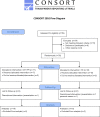Effects of specific inspiratory muscle training combined with whole-body endurance training program on balance in COPD patients: Randomized controlled trial
- PMID: 34555068
- PMCID: PMC8460029
- DOI: 10.1371/journal.pone.0257595
Effects of specific inspiratory muscle training combined with whole-body endurance training program on balance in COPD patients: Randomized controlled trial
Abstract
Purpose: This study aims to assess the effect of inspiratory muscle training (IMT) combined with endurance training (ET) on balance in patients with chronic obstructive pulmonary disease (COPD).
Methods: We studied 32 male patients (62 ± 6 years) with moderate to very severe COPD. They were randomly assigned to an experimental group (IMT+ET) n = 16 or a control group (ET) n = 16 with similar characteristics. The evaluations were carried out at inclusion and after eight weeks of the training period. Functional balance was assessed by the Berg Balance Scale (BBS), the Timed-up and Go (TUG), the Single Leg Stance test (SLS), and the Activities-specific Balance Confidence (ABC) scale. The strength of the inspiratory muscles (PImax) was assessed by maximal inspiratory mouth pressure. Functional exercise performance was assessed by the 6 minutes walking test (6MWT). IMT program consists in performing two daily sets of 30 inspirations with 50% of PImax increased by 10% every two weeks. ET program consists in performing 30 min treadmill exercise at 60% to 80% of the average speed achieved during the 6MWT three days per week.
Results: After the training period, the experimental group demonstrated greater improvements in BBS (IMT+ET vs. ET; p = 0.019), and in ABC (IMT+ET vs. ET; p = 0.014). However, no significant differences between groups were observed for TUG, SLS, and 6MWT. There was a significant difference between groups in PImax (IMT+ET vs. ET; p = 0.030). Significant moderate correlations were obtained between ΔPImax and ΔBBS for both groups (IMT+ET: r = 0.624, p = 0.010; ET r = 0.550, p = 0.027) as well as for ΔABC but only in the experimental group (IMT+ET: r = 0.550, p = 0.027).
Conclusion: Compared to ET alone, the results suggest that IMT combined with ET enhances inspiratory muscle function and functional balance according to BBS and ABC in patients with COPD. We suggest that inspiratory muscle training might be introduced as additional training to pulmonary rehabilitation programs aimed at improving balance in COPD patients.
Trial registration: The trial registry name: Clinical Trials; Registration number: NCT04084405; URL: https://clinicaltrials.gov/ct2/show/NCT04084405.
Conflict of interest statement
The authors have declared that no competing interests exist.
Figures
References
-
- Diagnosis C, To PG. Global Strategy for Prevention, Diagnosis and Management of COPD. Gold Rep. 2019.
-
- Vanfleteren LEGW, Spruit MA, Groenen M, Gaffron S, Van Empel VPM, Bruijnzeel PLB, et al.. Clusters of comorbidities based on validated objective measurements and systemic inflammation in patients with chronic obstructive pulmonary disease. Am J Respir Crit Care Med. 2013;187(7):728–35. doi: 10.1164/rccm.201209-1665OC - DOI - PubMed
Publication types
MeSH terms
Associated data
LinkOut - more resources
Full Text Sources
Medical


